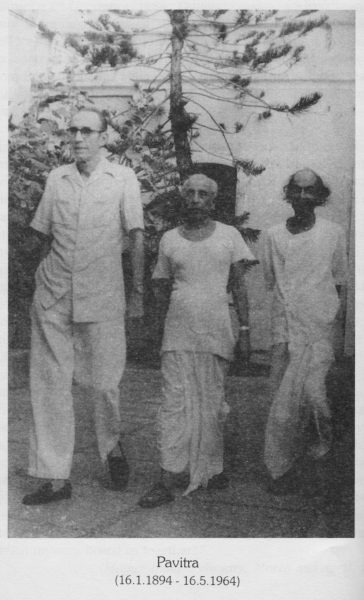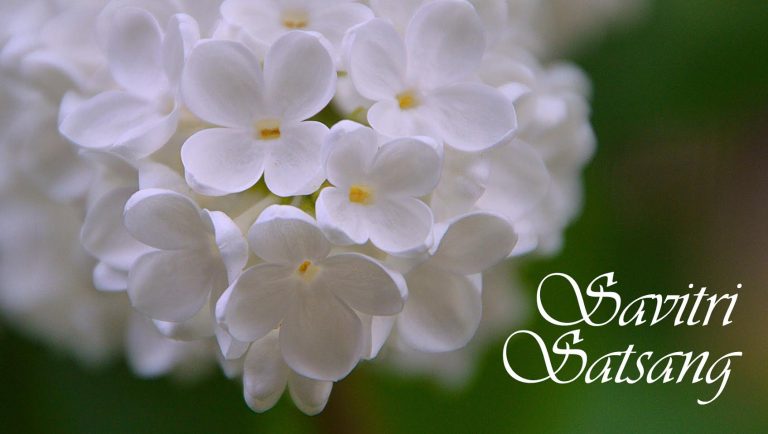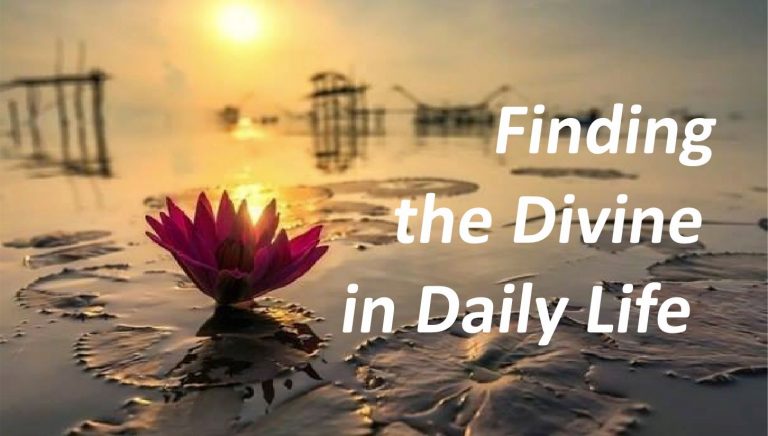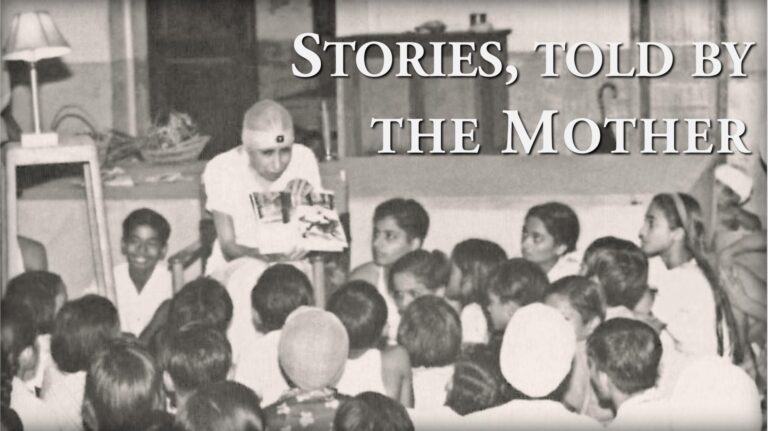
Within a few months we have lost two of our dear elder brothers, both of them early pioneers of our Yoga and pillars of strength to us: Amrita-da and Pavitra-da. Pavitra-da, to whom I offer my humble homage today, will be especially remembered by you since he was the Director of our Centre. Though many of you had no close contact with him, you must have often observed him coming to the Centre with a serene smiling face, walking with long firm steps, a tall and slim figure not likely to be missed by anyone old or young. You have also heard him calling out your names at the Playground during the prize distributions before the Mother.
When I first arrived at the Ashram, I was very much impressed by his appearance and bright complexion. I used to meet him every Prosperity Day, on the first of each month, when, standing by the Mother’s chair, he would distribute our respective “necessaries” with a friendly smile and an affectionate look. He would be clad in dhoti, punjabi and chaddar, and had a well-trimmed squarish beard. He looked like an apostle. To me, he seemed much more handsome with that beard and in that dress than in his later clean-shaven aspect and his return to European costume. But it made no difference to his bearing, by which one could easily make out that he came from distinguished European stock. In fact he belonged to an aristocratic French family and was a noble representative of French culture.
How and when from a distant land, leaving like Buddha his home, his relatives, his brilliant worldly prospects as a graduate of the Ecole Polytechnic, and wandering through Japan, China, Mongolia and Tibet in quest of the Unknown, he came at last to the land of Buddha and took permanent refuge at the feet of Sri Aurobindo — this strange saga you have already heard from his own lips. What I am going to tell you today are my own impressions of him that have been formed through a span of about thirty years. Though my contact with him was not very close, still I had ample occasion to see him from far and near, to hear about him now and then from Sri Aurobindo himself, and always to maintain a high regard for him. During the later years, as my contact became closer, since I was living in the same house, my regard increased and I found in him a man who rang true in every fibre of his being, a Yogi indeed of Sri Aurobindo’s Yoga. To be able to say that is not a small thing. You are still young, and to be young is “very heaven”, but to us old people at least to me, Sri Aurobindo’s Yoga has at times given a good dose of hell. I am consoled only by his statement that hell is the shortest cut to heaven.
The Mother is reported to have remarked that from the very first day Pavitra-da kept on the right path, without vacillation. You might find here an echo of what Sri Aurobindo said about his own self, that he never turned to the right or to the left after he had settled himself in Pondicherry. I am reminded also of a Mantra in the Rig Veda. Aditi, the infinite Mother, cries in the ancient hymn to Indra, the divine Power about to be born from her womb: “This is the path of old discovered again, by which all the gods rose up into birth, even by that upward way shouldst thou be born in thy increase; but go not forth by this other to turn thy mother to her fall.” And Pavitra-da, a true son of Aditi, kept to this upward way all through.
Who is Aditi? I will make a short digression. Champaklal once, on his birthday, made two paintings: one of a white lotus, the other of a red lotus. Don’t think that because he is now preparing for you only birthday cards or has been doing ‘marble painting’ he knows no other art. The Mother has called him ‘master of cards’. We used to call him ‘master of lotus painting’. When he offered those two paintings to the Mother, she said, “I will show them to Sri Aurobindo and ask him to write on them his blessings.” Champaklal replied, “Mother, you can then ask him to write something on them.” Champaklal added to me, “On the white lotus Sri Aurobindo wrote ‘Aditi’, and on the red one Mother wrote ‘Avatar’, and she asked me not to show them to anyone.” “Why not?” I asked. “She said people would not understand,” Champaklal replied.
Now we may come to the main point of interest. What was Pavitra-da’s relation with Aditi, the divine Mother? Champaklal again tells me that the very first time the Mother saw Pavitra-da, she said to Champaklal, “I have told Sri Aurobindo that he will do my work of foreign correspondence.” Champaklal added, “Mother founded a small carpentry where I was asked to do some carpentry work Mother asked him also to work there and he made a table to iron clothes on.”
You know that the part of the building in which Pavitra-da lived is connected through a long corridor with the Mother’s quarters. It was so designed in order that she might have free access to him and he could be at her call at all times. She would visit him at any hour of the day for one thing or another. More than once Sisir was surprised in his talk with him on School matters by her sudden appearance. She gave Sisir some advice and left. Another day, long after, I heard her coming out of her bathroom at about 6 a.m. shouting, actually shouting, “Pavitra, Pavitra!” I got a bit alarmed. God knows what he was doing, shaving or taking coffee. He cried back, “Oui, Mère!” and came almost running. She scolded him about some School matter and he quietly and submissively listened. I have heard also that the Mother on her way to the Balcony darshan would pass through his bedroom and if she found him still sleeping, would rouse him out! These are small instances, but it is the small incidents that reveal the intimacy of the relation between the Mother and the child. You also know that Pavitra-da was the driver of the Mother’s car from the beginning of the Ashram. She would not trust anyone else. He would take her to the Tennis Court, back to the Playground, wait long hours if necessary, and then bring her back home. Even on all her excursions, in the early days of the Ashram, it was he who acted as the driver. Sri Krishna was the charioteer of Arjuna in the battle of Kurukshetra, and Pavitra-da was the driver of the Divine Mother in the highways of the world! My friend Nishikanta, who had the faculty of occult vision, told me that once as Pavitra-da was taking the Mother out in the car, he saw that the car was being pulled by several pairs of spirited horses (I don’t remember their number or colour) with a sovereign galloping speed. It was at one time Pavitra-da’s part too to call the Doctor whenever the Mother felt a need for him. All of which means that, to adapt a verse from Savitri, she could bring out the relation so truly and profoundly. I have also seen him kneeling in a quiet simple manner before the Mother, receiving a flower from her. This intimacy did not make him forget that she before whom he knelt was no other than the divine Mother Herself. When on the Mother’s 80th birthday, the Pathamandir of Calcutta asked Pavitra-da to write something on his experiences in Sadhana with her, he replied that this was a matter too intimate to be disclosed to the public.
To be so near and intimate, what a wonderful boon! you might say; but it is not so easy a boon to keep. For, the Mother being the Shakti, there is an automatic pressure for change on those who are near her and there are very few who can bear that pressure. I shall tell you of my own experience. When I came near to Sri Aurobindo to serve him, I was like a green leaf. Basking in the golden rays of the morning sun, I became fresh, strong and blithe, but as years wore on, the green turned, not “one red”, but a mixed patchwork of red, brown and grey: the rays were too bright!
Now I will give you another example to show how the Mother’s very presence acts. Once Sri Aurobindo, lying like Lord Shiva in his bed, was amusing us, his pramathas, with the story of his student life in England. His voice was soft and subdued and we were listening raptly, lest a single word should be missed. Suddenly he said, almost in a whisper, “The Mother is coming!” All at once turning our backs and sides to him, we sat straight like so many good boys and waited for her arrival. She sized up the situation and said, with a gracious smile, “They are making you talk?” and went back.
I needn’t multiply instances to prove the dynamic, almost electric effect of her presence. All of you are familiar with it. Pavitra-da and others who were near her had to bear the full current of that power and, I am sure, they bore it well, for, first of all, they had a long period of preparation before the blessed “subconscient” started working when we came; and then, they were greater adharas who “saw, felt, knew the deity,” and “She held their hands, she chose for them their paths.”
2
What was Pavitra-da’s relation with us? His closeness to the Mother did not make any difference to it. Both Amrita-da and Pavitra-da were so much like us in their outer ways, manners and behaviour, that their “exterior semblance very often belied their soul’s immensity.” Pavitra-da, when he first came to the Ashram, was supposed to have said that he was a brother to all, and indeed he ever maintained the French ideal of equality and fraternity with all, high and low, young and old. You must have noticed that at the Theatre he used to sit with all of you on the ‘parterre’ instead of on a chair. One never came from a meeting with him without carrying away some sweetness, light and purity. Purity, sweetness and light were indeed his inborn psychic qualities. The name “Pavitra” given to him by Sri Aurobindo could not have been more appropriate. One could feel a white light wrapping him like a fine vesture wherever he went. I often saw him sitting in meditation on his terrace, and on moonlit nights the moonbeams filtering through the leaves of the Service Tree bathed him with a light “that never was on sea or land,” as if a Japanese Buddha had been sitting there, deep in trance.
About the prodigious amount of work he used to do, I think many of you have heard; and everything was done methodically down to the minutest detail. I never saw his light going out before 11 p.m., after which he would always come down, do pranam at the Samadhi, pace for a while and go back. The worker side of his personality has been described very well in the article in the Mother India of June. I can only add that the hair oil, eye lotion, tooth powder, shaving cream, etc., that make you spick and span, were prepared according to his instructions. He was a Polytechnician in both the senses. You can see then how indispensable he was to the service of the Mother. When the vacuum cleaner was used for the first time, it was he whom the Mother called to clean Sri Aurobindo’s room, and the radio was also set-up there and operated by him. You may argue that there are plenty of people who could do so much work, but to do it all with a constant calm and dedicated spirit would not have been possible unless one had walked on what Sri Aurobindo has called the sunlit path. And how thorough he was! Once when I took to him an article written in French, he verified all the references, corrected the small slips and, to my surprise, even corrected my lavish use of el ceteras instead of, at most, two at a time, and of commas before or after the brackets! I was reminded of the Guru’s practice in such minor matters. We had occasions to break lances with Pavitra-da in connection with our School work but that did not affect our spiritual relationship. He always maintained his poise and equanimity and sweetness. I don’t mean that he had no inner difficulties, but he never allowed them to intrude upon his outer nature and I would go further and assert that without a considerable inner development such an outer conquest is not possible. Sri Aurobindo’ stress on “change of the outer nature” found in him an exceptional response.
I shall relate to you a striking instance of Pavitra’da’s equanimity and submission to the Divine Will. You have been told of his entering the First World War and going through its terrible ordeal. Now when the Second War broke out, he was supposed, as a French Citizen, and ‘un ancien combattant’, to take part in it. An order came to the effect that he must resume military training in Pondicherry, preparatory perhaps to going to the battlefield. The Mother had to consent to it, since there was no way out. My colleague said that on the eve of his joining the parade, the Mother brought a garland to be offered by Pavitra-da to Sri Aurobindo, and Pavitra-da followed and did pranam to him, seeking his blessings. Every morning he would go out in his uniform and return after a few hours with a smiling face and a cheerful spirit. But the development that we all awaited with apprehension was not long in coming. There was a rumour that he would soon be called to the Front. The Mother was very much loth to let him go. In our talks with Sri Aurobindo he would refer to the Mother’s strong unwillingness: Pavitra-da had become a part of their being and was so indispensable that the Mother could not do without him. Though she was rather vexed, she found no normal way out of the impasse. We were all sore on his account and were waiting with fear for the order to come, but at the same time hoping that some miracle would happen preventing his departure. The Mother asked him to get ready. She did not take any chance. We did not hear of any perturbation on his part. Since the War had already been named the Mother’s war, and our people were taking part in it, Pavitra-da also must have accepted it in the same spirit. But to leave the Ashram-home, after spending the best part of one’s life in close association with the Mother and Sri Aurobindo, for an uncertain, even perilous, future, is, to say the least, not easily done. He began to prepare himself and, among external things, what he was particular about taking with him was a stove which, it seems, he had designed himself and got made in his atelier.
At last the order arrived that he would leave by such and such a steamer that would touch Pondicherry on such and such a date. We were counting the days. But the ship never arrived! We were startled to learn that the ship had been torpedoed somewhere along the way. Was it the hand of Providence that acted in so drastic order to save a yogi from a calamitous end? Na me bhakta pransyati. My bhakta does not perish, says Sri Krishna. No other ship arrived either, for, very soon after this, Pondicherry declared itself for De Gaulle. Whatever the reason might have been, we saw Pavitra-da employed here to transmit War news from his radio to Sri Aurobindo four or five times a day!
This was somewhere in the early forties, I believe. Since then much water has flown under many bridges and many a change has come about in our life here. Youngsters invaded the Ashram in a flood and a school had to be started, of which Pavitra-da was made the Director. From a very small beginning the Centre has grown steadily to its present distinguished stature and acquired an international status. Behind this distinction, there was in no small measure the incessant activity and living interest of Pavitra-da who always kept in his dreams and in his wakeful moments the thought of the Centre in the forefront of his mind, consulted the Mother at every step and carried out her wishes. Things were moving splendidly. Many Government Commissions came and went; we received partial recognition, and some grants. Various changes and experiments took place in our educational system and the Centre was ever expanding. There was every reason to hope that it was going to be a unique institution embodying the ideals of Sri Aurobindo, and all of us were working towards that ideal when one day we heard that Pavitra-da was not well. His movements and his meeting with us and with others became gradually more and more restricted: finally he was confined to his own room and to his contact with the Mother.
There is a darkness in terrestrial things
That will not suffer long too glad a note.[1]
Now I will touch upon the last and most painful episode of Pavitra-da’s life and the supreme example of his equanimity. At first we thought it was just a passing illness. He seems to have come to know from the doctor about its nature nearly one year after the initial onset and, thereafter, it was a strictly guarded secret. Vague forebodings crossed our minds, but these were dissipated when we saw him carrying on his work cheerfully and always meeting us with a glad smile. We were deceived by the restricted movements of the joints and took them to be symptoms of some kind of rheumatism. Besides, there followed a period when we used to see him walking briskly in the corridor, even running and doing many other minor exercises. Every morning we would greet each other with a bonjour or a silent nod. The rigidity that had rendered the movement difficult and painful seemed to have gone and we were all so happy to anticipate a complete cure. But the symptoms came back and took their unrelenting course. Gradually he had to stop all exercises and we used to see him moving about with a stick, dragging his affected leg. Later on, he was moving almost like an ant, taking half an hour or more to reach the staircase of the Mother’s room from his own. Still with this extreme incapacity and, I am sure, constant gnawing pain and other sequelae, he went on doing all his duties till the last day. His personal servant said that he would take about half an hour to cross a few yards in order to reach his bureau. Yet there was no dark shadow on his face. Sri Aurobindo always used to urge upon us the lesson of equanimity, such an equanimity that nothing in the world could disturb it. It is the very rock basis of sadhana and I am certain that Pavitra-da achieved it in great measure. In the later phases I tried always to avoid him, the pale face and creeping-like walk were too painful for me, but sometimes I would be caught while he, along with André, was on his way to the Mother. Greetings were exchanged and he was as calm, as tall and upright as before.
I have said that the nature of the malady was kept a secret, but when I came across the truth just by accident a few days before his passing, I simply gasped. To know very well the character and progress of the disease for so many years, and to remain still undisturbed, calm and ungrieved, doing all his daily work — shall I not call this a victory of what Wordsworth terms “man’s unconquerable mind”? Was this not a heroic soul, a Vibhuti, a Yogi? I was told that when he learnt for the first time what his ailment was, he did not seem in the least perturbed, and he kept a graphic record of his symptoms till the last day. I could not but compare what I believe would have been my reaction if I had been in his position, but the less said about it the better.
Pavitra-da fought the battle of Kurukshetra in his body for five long years against an adversary who remains still unconquered in the medical world. He may have failed, but I am convinced that he fought not only for himself but for the world, and half the battle has been won by his superb effort. An unprecedented yagna is being performed; it demands priceless sacrifices. The first Greek king who touched the Trojan soil had to lay down his life. Great souls, mighty adharas, have to bear enormous burdens, not for themselves alone, but for us mortals too. “… must fire always test the great of soul?” It is they who help to lift the weary weight of this unintelligible world and make life bearable to us. From Pavitra-da’s luminous example we can learn what true greatness is like. Indeed the Mother has given an exceedingly high place to his spiritual achievement.
Presences like his amongst us serve as a steady light on the voyage of our soul. Why not give the example, I might be asked, of the Mother and Sri Aurobindo? The Mother is the light of a thousand suns, and through such as Pavitra-da she shines tempered and transparent. They are nearer to us as our elders. One who says that even in her cradle she was conscious of belonging to another world, “the child remembering inly a far home”, and the other who had the Nirvanic experience in three days — they are too great for us mortals as examples. In spite of many beatings from the Guru on this point, I remain still unrepentant and incorrigible, feeling a gap between such beings and ourselves. But people like Pavitra-da are near us, are our kindred, for all their high attainments. Sri Aurobindo once wrote to me that there were at least a few here who have had the Brahmic experience. I fell that Pavitra-da was one of them. His total surrender to the Mother, his wide self-giving, were surely the result of major spiritual experiences. These must have laid the ‘shining axe of God’ at the root all doubts and perplexities and annihilated all denials and oppositions — bhidyate hrdaya-granthi, cchidyate sarvasamsayan. Sri Aurobindo told Pavitra-da at their first meeting that he could realise what he was seeking — liberation — but there were also many other things besides that in Yoga. Seeing Yogis like him and moving among them we too can hope for the Highest and, adapting Francis Thompson, say:
О Invisible, we view thee,
О Intangible, we touch thee,
О Unknowable, we know thee.
Inapprehensible, we clutch thee.
(Mother India, August 15, 1969)
[1] Savitri p. 17



